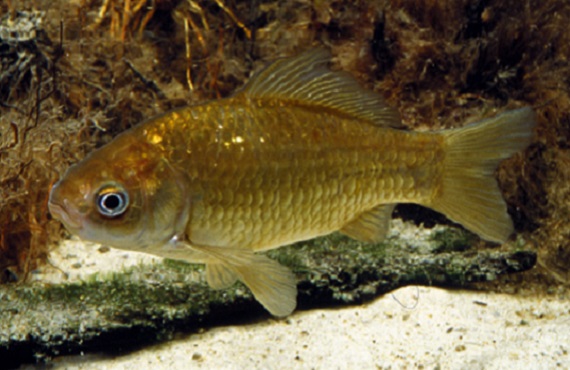Goldfish
Introduction
 Goldfish were originally imported into NSW as a colourful and easy to maintain coldwater aquarium fish. Over many decades they have become widely distributed throughout lowland rivers.
Goldfish were originally imported into NSW as a colourful and easy to maintain coldwater aquarium fish. Over many decades they have become widely distributed throughout lowland rivers.
Goldfish are related to carp (both from the Cyprinidae family) and feed mostly on small shellfish and plant material. They survive in still and sluggish water and can tolerate relatively high temperatures and low oxygen levels. Goldfish reproduce in summer. A large fish can lay several hundred eggs which hatch in about a week. Observations made by DPIRD research staff suggest that goldfish can be a food source for some predatory freshwater fish such as Murray cod. Goldfish are commonly up to 200 mm in size but can reach 400 mm.
Impacts on native fish
Despite being related to carp, little is known about the impact goldfish have on native fish, particularly regarding the competition for food, resources and habitat. Few detrimental effects have been recorded, however, this may be due to limited research. One impact that has been well recorded is the transmission of disease.
Goldfish ulcer disease (GUD) is a bacterial disease first isolated from a goldfish farm in Victoria in 1974. Since then, outbreaks have occurred at warm water fish hatcheries in NSW and Victoria. NSW DPIRD researchers have found that fingerlings of Murray cod, golden perch and silver perch are resistant to GUD. However, there has been one recorded outbreak of the disease in a silver perch fish farm in NSW. Trout are at high risk of infection.
What can we do?
Well-established introduced aquatic species are difficult to control. However, there are some options for pest fish management and improving the odds for native fish.
Environmental management and aquatic habitat rehabilitation.
Management of issues such as water quality, environmental flows, fish passage and snags can maintain or return conditions to those that best suit native fish. This improves the ability of native fish to compete and creates conditions less suitable for introduced pest species. Protection and restoration of fish habitats through aquatic habitat rehabilitation can help to tip the balance in favour of native fish and away from introduced pest fish.
NSW DPIRD is involved in several aquatic habitat rehabilitation projects funded by local, state or federal bodies including councils, the former Catchment Management Authorities (now Local Land Services), and the Murray-Darling Basin Authority. Current projects include actions such as replanting riparian (riverbank) areas, returning woody debris (‘snags’) to rivers as fish habitat, and building fish ladders to allow fish to pass in-stream barriers, such as weirs.
Angling clubs, community groups, local councils, Landcare and Rivercare groups and individuals interested in rehabilitating fish habitats throughout NSW can apply for grants. Some grants are made available from the Recreational Fishing Trust using funds generated by recreational fishing licence fees.
Restricting the spread
The spread of introduced pest species has often been associated with their use as bait. For this reason, use of live fish as bait is illegal in NSW. Improved education is also needed to avoid the accidental release of these species.
NSW DPIRD has an extensive education program to promote community awareness of pest fish in particular in promotion of the responsible keeping of pet fish. See Aquarium owners and trade section for more on choosing which fish to keep, rehoming unwanted fish and details on prohibited ornamental fish species.
If you find what you believe is a goldfish (or another species which you suspect is not native to the area), take a digital photo if possible and report it to NSW DPIRD Aquatic Biosecurity.
How can you help
- Don’t return pest fish to the water – if you catch a pest fish dispatch it humanely and utilise or dispose of it appropriately.
- Keep a lookout for suspected pest fish in your local waterways and report suspected new locations
- Don’t transfer fish between waterways, and don’t use live fish as bait in freshwater - it’s illegal!
- Never dump or release fish for any reason, including for recreational fishing, environmental or cultural purposes – this can spread disease and result in a species becoming a pest.
- Obtain a permit to stock fish and buy fingerlings from a registered hatchery to minimise the chances of purchasing juvenile fish contaminated with undesirable species.
- Prevent unwanted hitchhikers – check, clean and dry boats and gear between waterways.
- Design fishponds so that plants, snails, fish or eggs can not escape during heavy rains, and screen all overflow areas.
- It is illegal to buy fish, plants or ‘live rock’ from overseas on the internet; instead purchase them from a reputable local dealer.
- Assist efforts to restore our rivers (which can help native fauna to out-compete pest fish), for example by taking part on a RiverCare or LandCare project or by conserving and restoring riparian vegetation on your own land.
- Take part in native fish restocking programs with your local angling group.
References and further reading
- Harris, JH and Gehrke, PC (eds). 1997. Fish and Rivers in Stress. The NSW Rivers Survey. NSW Fisheries Office of Conservation and the Cooperative Research Centre for Freshwater Ecology in association with NSW Resource and Conservation Assessment Council.
- Rowland, SJ and Ingram, BA. 1991. Diseases of Australian native freshwater fishes with particular emphasis on ectoparasitic and fungal diseases of Murray cod (Macullochella peelii peelii), golden perch (Macquaria ambigua) and silver perch (Bidyanus bidyanus). Fisheries Bulletin 4. NSW Fisheries.
- Young, WJ. (eds) 2001. Rivers as Ecological Systems: The Murray-Darling Basin. Murray-Darling Basin Commission. Canberra.